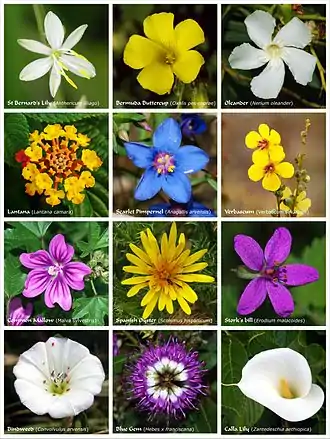Lamiales
The Lamiales are an order in the asterid group of dicotyledonous flowering plants. It includes about 23,810[2] species, 1,059 genera, and is divided into about 24 families. Well-known or economically important members of this order include lavender, lilac, olive, jasmine, the ash tree, teak, snapdragon, sesame, psyllium, garden sage, and a number of table herbs such as mint, basil, and rosemary.
Description
Although exceptions often occur, species in this order typically have the following characteristics:
Taxonomy
The Lamiales previously had a restricted circumscription (e.g., by Arthur Cronquist) that included the major families Lamiaceae (Labiatae), Verbenaceae, and Boraginaceae, plus a few smaller families. In the classification system of Dahlgren the Lamiales were in the superorder Lamiiflorae (also called Lamianae). Recent phylogenetic work has shown the Lamiales are polyphyletic with respect to order Scrophulariales and the two groups are now usually combined in a single order that also includes the former orders Hippuridales and Plantaginales. Lamiales has become the preferred name for this much larger combined group. The placement of the Boraginaceae is unclear, but phylogenetic work shows this family does not belong in Lamiales.
Also, the circumscription of family Scrophulariaceae, formerly a paraphyletic group defined primarily by plesiomorphic characters and from within which numerous other families of the Lamiales were derived, has been radically altered to create a number of smaller, better-defined, and putatively monophyletic families.
Dating
Much research has been conducted in recent years regarding the dating the Lamiales lineage, although there still remains some ambiguity. A 2004 study, on the molecular phylogenetic dating of asterid flowering plants, estimated 106 million years (MY) for the stem lineage of Lamiales.[4] A 2009 study on angiosperm diversification through time, concluded an inferred age of lower Eocene, ca. 50 MY, for Lamiales.[5]
References
- M. E. J. Chandler. 1964. The Lower Tertiary Floras of Southern England. IV. A summary and survey of findings in the light of recent botanical observations.
- Angiosperm Phylogeny Group (2009). "An update of the Angiosperm Phylogeny Group classification for the orders and families of flowering plants: APG III". Botanical Journal of the Linnean Society. 161 (2): 105–121. doi:10.1111/j.1095-8339.2009.00996.x.
- Angiosperm Phylogeny Group (2016). "An update of the Angiosperm Phylogeny Group classification for the orders and families of flowering plants: APG IV". Botanical Journal of the Linnean Society. 181 (1): 1–20. doi:10.1111/boj.12385.
- Bremer, K.; Friis, E. M.; Bremer, B. (2004). "Molecular phylogenetic dating of asterid flowering plants shows early Cretaceous diversification". Systematic Biology. 53 (3): 496–505. doi:10.1080/10635150490445913. ISSN 1063-5157. PMID 15503676.
- Magallón, S.; Castillo, A. (2009). "Angiosperm diversification through time". American Journal of Botany. 96 (1): 349–365. doi:10.3732/ajb.0800060. ISSN 0002-9122. PMID 21628193.
External links
- Lamiales
- A parsimony analysis of the Asteridae sensu lato based on rbcL sequences
- Disintegration of the Scrophulariaceae (deals with relationships throughout Lamiales)
- L. Watson and M.J. Dallwitz (1992 onwards). The families of flowering plants: descriptions, illustrations, identification, information retrieval. http://delta-intkey.com
- https://web.archive.org/web/20070609093942/http://www.biologie.uni-hamburg.de/b-online/vascular/acanth.htm 2002-09-06
- https://web.archive.org/web/20070630151231/http://www.biologie.uni-hamburg.de/b-online/d52/52e.htm 2002-09-06
- https://web.archive.org/web/20070609093206/http://www.biologie.uni-hamburg.de/b-online/d52/52efam.htm 2002-09-06
- https://web.archive.org/web/20050914001131/http://www.science.siu.edu/parasitic-plants/Relation-Scroph.html
- https://web.archive.org/web/20070311032641/http://www.rbgkew.org.uk/web.dbs/genlist.html 2002-09-06
| Wikimedia Commons has media related to Lamiales. |
| Wikispecies has information related to Lamiales. |
.jpg.webp)
